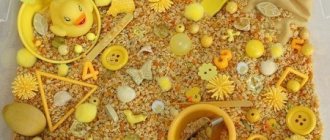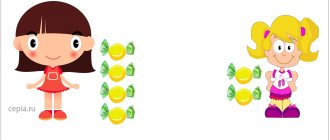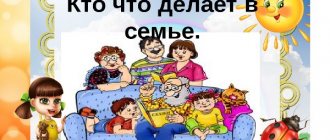Summary of an open lesson by a psychologist with children of the middle group “Tsvetik-Semitsvetik”
Summary of
an open lesson by a psychologist with children of the middle group
“ Tsvetik-semitsvetik ”
Lesson summary for the middle group “ Tsvetik-Semitsvetik ”.
Purpose of the lesson:
development and correction of the cognitive and emotional-volitional sphere.
Correction and development tasks:
development of attention (voluntary and involuntary), stability of attention;
memory development (short-term and long-term);
development of auditory perception;
development of fine motor skills of the hands and gross motor skills
correction and development of the child’s emotional sphere: reduction of anxiety, tension, aggressiveness, excitability
development of the volitional sphere: skills of self-control, perseverance and endurance, the ability to express one’s feelings.
Preliminary work:
— watching the cartoon “Tsvetik-seventsvetik”,
- learning words from fairy tales with children:
Fly, fly - petal
Through West to East...
Material used:
a hoop, multi-colored ribbons, a “seven-flowered flower” made from balloons, 10 orange balloons, a blue scarf, blue colored paper, purple paper butterflies.
PROGRESS OF THE CLASS
- Organizing time
Children enter the music room to the music from the cartoon “Tsvetik-seventsvetik”.
Stand in a circle with a psychologist.
Psychologist (P.):
All the guys stood in a circle, You are my friend and I am your friend, Let's hold hands tightly and smile at each other We wish everyone well Good morning, good day!!!
P.:
Guys, we have guests today. Let's say hello to them too and smile at our guests. (greeting children)
P.:
Guys, do you like to travel? (children's answers)
P.:
Today we will go on a journey. And our journey is completely unusual, it is fabulous and colorful. And to start it, you and I need to go through the wonderful multi-colored gates. (Children walk through colorful ribbons to the music).
I I. Main part
P.:
Our journey begins...
(The “Seven-flowered flower” appears in the psychologist’s hands.)
P.:
Guys, look at this wonderful flower. What is it called? (children's answers). - That's right, it's a seven-flowered flower!
P.:
Do you remember watching this cartoon?
P.:
Let's remember together what magic words the girl Zhenya said?
(children tear off a red
petal from a flower and pronounce the words from the cartoon: “Fly, fly, petal...”)
1. P.:
Fly around the earth
To be in my opinion led!
I order you guys to guess the riddles. And these riddles are not easy, because all the answers will be red.
Exercise “Guess the riddle.”
The goal is to develop auditory perception of thinking, observation, memory, speech, and expand vocabulary.
* Mom said to Borya:
“We won’t go now - it’s dangerous!” Because the traffic light is not green, but... (Red)
*He gives us tomato juice,
Tasty, tender, aromatic. Signor loves the sun - Ripe red... (tomato)
*At the edge of the forest, near the path
It grows on a white stem. The Poisonous pine forest is painted red ... (fly agaric)
* Red beads hang
from the bushes looking at us, Children, birds and bears love these beads very much (raspberry)
*Grandmother loved the girl very much
Gave her a red cap
The girl forgot her name
Well, tell him, guys!
(Little Red Riding Hood
)
2. P.:
Let's move on, guys?
The next petal is orange.
Children tear off orange
petal and say the words: “Fly, fly, petal...”
P.:
Fly around the earth
To be in my opinion led!
I order you guys to turn into a cheerful orange train. Shall we play?
Exercise with balloons “Merry little train”.
The goal is to establish trusting contact with children, unite the group, and create a positive attitude.
Children squeeze the balls between their tummies, trying not to help themselves with their hands, and move to the music. As soon as the music ends, the “train” stops.
3. Guys, do you like our trip? (children's answers). Let's move on.
Children tear off yellow
petal and say the words: “Fly, fly, petal...”
P.:
Fly around the earth
To be in my opinion led!
I order you guys to sing and dance the yellow song.
Exercise “Yellow Song”.
The goal is the development of auditory perception, coordination of speech with movement.
The yellow sun looks at the earth
(hands up, stretched, eyes up)
A yellow sunflower is watching the sun
(swinging hands left and right)
Yellow pears are hanging on the branches
(shaking hands down)
Yellow leaves are flying from the trees
(swinging hands up and down)
Yellow sun, yellow sand
Yellow is the color of joy, rejoice, my friend!(
jumping in place
).
4. Children tear off the green
petal and say the words: “Fly, fly, petal...”
P.:
Fly around the earth
To be in my opinion led!
I command that you guys turn into green inhabitants of our planet. Just first tell me, please, which green inhabitants of nature do you know - animals, birds, insects? (children's answers).
Exercise “Green inhabitants of nature.”
The goal is to reduce the level of excitability, anxiety, and hyperactivity.
Now each of you will turn into a green creature. 1st subgroup - frogs (jump), 2nd - grasshoppers (jump), 3rd - snakes (crawl), 4th - butterflies - butterflies (fly).
Children take turns showing how they will move. Then they all move together to the music. When the music stops, you need to freeze in place.
5.
Children tear off
a blue
petal and say the words: “Fly, fly, petal...”
P.:
Fly around the earth
To be in my opinion led!
I order you guys to play in the snow!
Exercise "Paper balls".
The goal is to reduce the level of aggression and help release anger, muscle and emotional tension.
Children are divided into two teams. There are blue leaves in front of the children. First, they crumple up these leaves and turn them into paper balls. Then, to the music, the children throw balls at each other. The game stops when the music ends.
6.
Children tear off
a blue
petal and say the words: “Fly, fly, petal...”
P.:
Fly around the earth
To be in my opinion led!
I order you guys to hide under this beautiful blue scarf!
Exercise “Hide and Seek with a Scarf”
The goal is the development of perception and memory. Helps reduce emotional anxiety and fear of the dark.
All children squat down and close their eyes.
P.: “We’re playing hide and seek, the kids are hiding!” One child is discreetly covered with a scarf. P.: “One, two, three! Who's hiding inside? You guys don't yawn! Answer quickly!” Children guess which of the children was hidden.
7. Guys, our journey is coming to an end. purple petal
colors.
Children tear off a petal and say the words: “Fly, fly, petal...”
P.:
Fly around the earth
To be in my opinion led!
I tell you guys to get some rest. Now you will turn into these wonderful beautiful purple butterflies.
Exercise "Relaxation".
The goal is muscular and emotional relaxation, restoration of strength, and a positive attitude towards future activities.
Now guys, imagine that you have turned into butterflies. Fly quietly and flap your wings.
And now the butterflies lay down to rest.
The eyes are closed. Listen to what I have to tell you . We now find ourselves in a sunny clearing, where grasshoppers chirp quietly, colorful butterflies fly and birds sing faintly. The breeze easily touches your face, arms and whole body. You are very warm and pleasant, you are resting and relaxing.
I will count from five to one, and when “one” sounds, you will open your eyes, and all your strength will return to you, your mood will be joyful and cheerful.
Guys, our journey is ending, it's time to return to the group. And to do this we need to go back through the multi-colored gates.
Reflection.
Did you enjoy the trip? What did you like most?
Children's answers.
Open lesson by educational psychologist “A Place in the Sun”
OPEN CLASS OF TEACHER-PSYCHOLOGIST
"A place under the sun"
Developer:
teacher-psychologist of the municipal educational institution "Secondary school in the village of Ivanteevka, Ivanteevsky district, Saratov region"
Kalenova Ksenia Andreevna
Relevance:
Currently, it is very important for teenagers to realize that they are in demand in society and to have life goals that have personal significance. It is important to help teenagers see how their choices can affect their future life and success in it, to find ways to achieve life goals, to interest them in realizing their plans, to teach them not to give up what they want when they fail, but to continue to move forward. This topic of the lesson is relevant because in adolescence, students become more interested in themselves, in their capabilities, abilities; adolescents are quite open to help from adults in overcoming difficulties, problems, and making decisions.
Audience:
teenagers aged 12 to 18 years. The quantitative composition of the group is from 6 to 10 people.
Target:
prevention of suicidal behavior, formation of the ability for self-knowledge, self-development and self-realization, development of motivation to achieve positive life goals.
Tasks:
creating conditions of emotional comfort;
prevention of suicidal behavior without using the word “suicide” during the lesson;
development of self-awareness in adolescents;
increasing communication skills and confidence;
updating life goals and increasing motivation to achieve them;
promoting group cohesion;
development of reflection.
Expected Result:
teenagers will acquire a desire for self-knowledge, self-development and self-realization, get acquainted with their inner world, gain experience in communication, listening skills, and reflect on their life values and guidelines.
Structural components of the lesson:
1. The introductory part is aimed at relieving emotional stress, creating a favorable, friendly atmosphere, psychological comfort and safety for each participant.
2. The main part is aimed at developing new knowledge and ideas, acquiring new skills and attitudes, constructing and practicing a personal strategy of behavior, comprehending the experience gained, and forming a value-significant personal concept of interaction with the world.
3. The final part includes summing up, intellectual and emotional reflection.
Contents of the lesson
Introductory part – 15 minutes
The teacher-psychologist welcomes students:
"Hello! Glad to see you again today. It’s spring outside, the first flowers are blooming, the sun is shining warmer. This is reflected in my good, pleasant and fresh mood, which looks like a clearing of the first yellow snowdrops.
Each of you has a different mood today. Perhaps it has some interesting color, shape, or smell. Think about your mood now.
In front of you you see many colorful shaggy wires. Using them, please depict an image of your mood. You can use several of these wires and complement the image of your mood with additional details: ribbons, beads.”
Discussion:
“I see you have finished creating an image of your mood today. Tell us why your mood image looks the way it does today, and how does it relate to your mood?
*Add. questions. Imagine that your mood began to deteriorate (improve). What could cause this to happen? How does your mood become? What will change first in your mood pattern?
Questions:
How was your work?
What emotions does the resulting image of your mood evoke today?
What's your mood today?
What's your mood like?
Let's fantasize a little, where does the image of your mood live?
How does it receive energy and charge?
What is its purpose?
What features does it have?
Who is looking after him?
How does your mood pattern today compare to you in life?
Main part – 25 minutes
Educational psychologist:
“Human life is full of many colors. And how good this picture of life turns out depends on the desires, goals, beliefs and actions of the person himself. Some devote themselves to creativity, while others scientifically explore patterns and relationships. Each of us is free to choose our own life guidelines. As we consciously answer the questions “what do I want”, “what can I do”, “what do I need now”, “who can I turn to for support”, “who can I give my support to”, We are taking our first independent steps towards finding our “place in the sun.”
How do you understand the expression “A place in the sun”? Teenagers' answers
.
You gave correct, quite accurate and interesting answers. The phraseological dictionary of the Russian language defines the expression “a place in the sun” as the possibility of a full-fledged and full-fledged existence. What do you think our lesson today will focus on? Teenagers' answers.
Educational psychologist:
“The body parts of various robots are laid out on the table.
The head is thoughts;
The body is feelings;
Legs are actions;
Imagine that you are robot creators. Each of you needs to create your own robot that looks like you. Please come up with a specific purpose for your robot, what it was created for, what goals and functions this robot has, what it can do best, how it can be useful to others. Color the robot the way you want using colored pencils, markers, pastels and clay." Students create their own robot, glue its body parts, and paint it.
In a circle:
“Now that your robots are ready, you need to introduce them.
This needs to be done in the following way: you need to imagine yourself in the image of your robot, its intonation, gestures, and facial expressions. Then present yourself on his behalf, in other words, be in the role of your robot and tell who he is, what he can do, what functions he has, what he likes, why he turned out the way he did, what he does, who he communicates with , how it is useful to others, what its purpose is.” Students talk about their robot and its purpose.
Educational psychologist:
Tell us how it worked for you?
Which part of the robot's body was the most difficult for you to choose? Why?
What is the purpose in life of your robots?
What emotions does the resulting image evoke?
Please tell me how you worked in pairs?
How is each of your robot similar to yourself?
Final part – 20 minutes
Educational psychologist:
“Look how different you have made your robots.
What do you think this could depend on?” Teenagers' answers.
Indeed, each person has his own worldview, his own goals, abilities, his own social circle, his own interests and hobbies. They can be useful not only for ourselves, but also for the people around us, in other words, when we communicate with each other, we have the opportunity not only to learn something new from someone, but also to convey our personal experience, which will be important, necessary and interesting for others.
The sun is shining brightly in our office. I suggest finding a place for your robots under it. Mark this place with colored crayons. Students glue their robots under the sun.
Reflection
Educational psychologist:
“In the meantime, our lesson is ending.
Please tell us how was your work today?
What emotions did our meeting today evoke?
What was the topic of today's lesson for you?
What new did you learn about yourself today?
Describe your impression of the lesson in one word.
In conclusion, I would like to wish you easy and interesting roads, a passionate desire to achieve your goals and sustainable motivation. Remember that the one who walks will master the road.”





